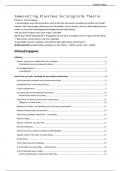Resumen
IB Sports Exercise Health Science Summary. Unit 3.1: nutrition.
- Institución
- Bachillerato
Summary of the IB SEHS Unit 3.1 (nutrition). You will find detailed yet summarized information on the topic, organized according to the IB syllabus (contains all necessary information to achieve a 7).
[Mostrar más]




